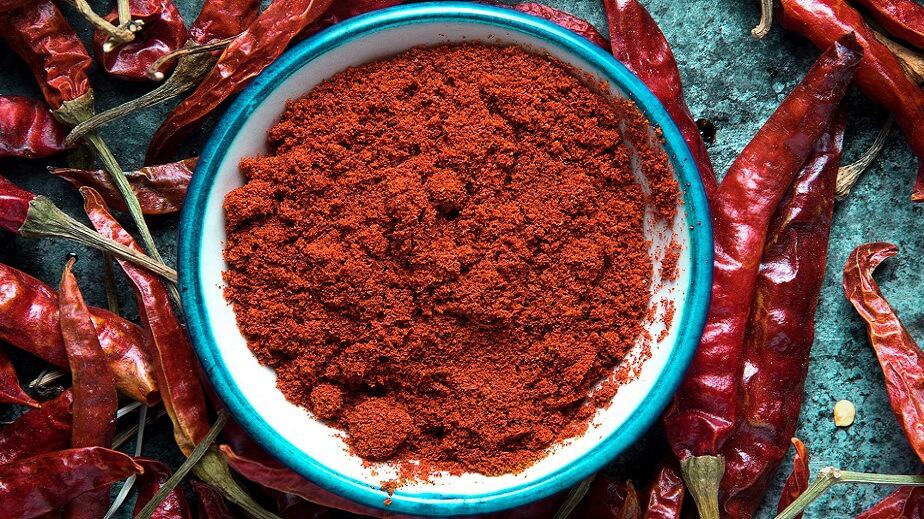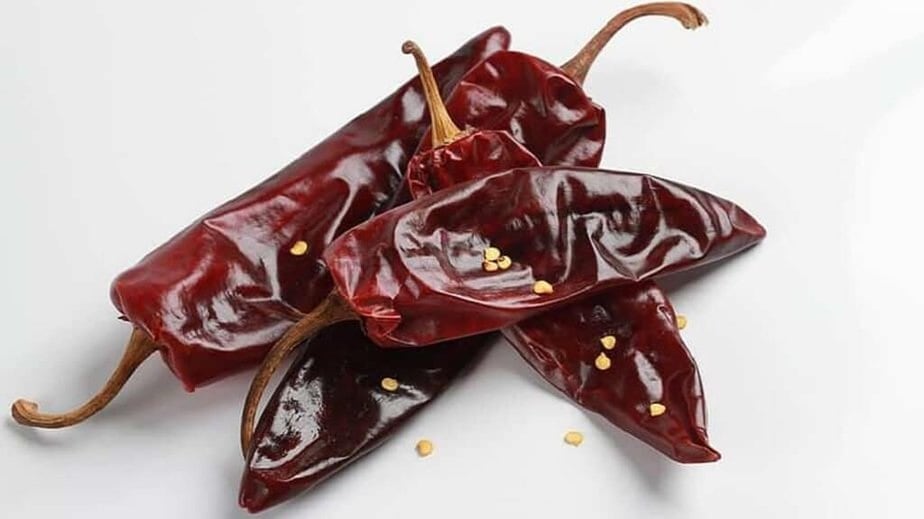What are Guajillo Chiles?
Guajillo Chile (also called chile guajillo or guajillo pepper) is the dried form of mirasol chile, a variety of chile peppers of the species of Capsicum annuum. Mexican farmers from the state of Zacatecas are chief producers of this chile. After poblano (ancho), this is the most popularly used chile in Mexican cuisines.
Mirasol, which means “looking at the sun,” is in reference to how these chiles grow pointing to the sky.
Mirasol peppers are allowed to age on the vine from their tender green stage into their mature brown-red color. When mature, they are picked for drying into Guajillos.
There are three Mirasol chiles, chile guajillo, chile puya, and chile cascabel; all of them have similar features. Chile cascabel is the closest in flavor to Guajillo chiles though slightly fruitier. Chile puya is smaller but spicier. Chile Guajillo is the largest Mirasol chile and has the richest flavor.
Along with Ancho and Pasilla peppers, this hot chile is part of the “holy trinity” of Mexican chiles.
Most groceries with Mexican spices sell this chile in whole, dried, ground, or paste forms.
Key Facts In A Gist
- Capsicum species: Annuum
- Origin: Mexico
- Other names: chile guajillo, chile cascabel ancho, guajillo chili, guajillo pepper, chile guaco
- Harvest: 58 to 70 days after transplanting
- Heat level: 2,500 – 5,000 SHU
- Median heat: 3,750 SHU
- Size: 3 to 5 inches long and1 inch diameter
- Shape: elongated, slightly curved
- Color: ripen from green to red/brown-red
- Flavor: sweet, fruity, tangy, smoky
- Uses: flavoring foods, condiments
- Products: fresh chili, dried chili, powder, rub, paste, sauces, ketchup
- Best Substitutes: Ancho chili, Pasilla pepper and Cascabel pepper
Guajillo Pepper Scoville
Guajillo peppers are medium-hot chiles that sit on the Scoville Scale between 2,500 to 5,000 SHU. In comparison to jalapenos (2,500 to 8,000 SHU), both of them are on equal footing but occasionally Jalapenos can be quite a bit hotter. This chile is 6 to 20 times milder than cayenne pepper (30,000 to 50,000 SHU).
While considering the dried chilies, Chipotle peppers share the near equal spiciness of Guajillos. Among the Holy Trinity of Mexican chilies, Guajillo is the hottest; Ancho pepper (dried poblano) ranges from 1,000 to 1,500 SHU, and Pasilla chilies range from 1,000 to 2,500 SHU.
Almost everyone will enjoy a milder range of medium-hot peppers; their spiciness is tolerable for most of us.
What Does Chile Guajillo Taste and Look Like?
Thick fleshed Guajillo peppers are about 2-4 inches long and roughly 1 inch wide. This chili has a raisin-like wrinkled texture and is elongated with a slight curve. As they mature, change color from green to reddish-brown and then to dark brown after drying.
They have a fruity, sweet, tangy, smoky flavor with hints of berries and tea. Guajillos are known for their deep flavor. Initially, you get the feel of fruity sweetness, and then come cranberry-like tanginess with a hint of tea-like crispness. Their smoky flavor makes them all the more delicious and appealing. Overall, it’s a complex chili, and there is no wonder why people love this chili so much.
How to Use Dried Guajillo Chiles?
When it comes to popularity and use, Guajillo is the most popular chili pepper in Mexican cooking, after the Ancho pepper. It’s part of the famous “Holy Trinity Chiles” commonly used in authentic Mexican mole sauces. Today, chile Guajillo is popular not only in Mexican cooking but also widely grown and used in the United States, China, Peru, and North Africa. Surprisingly, harissa chili paste, a popular North African seasoning has this chile as the key ingredient.
The unique flavor of this chile works great in sweet sauces and fruit recipes. Rehydrated chiles are used in stews, sauces, soups, and marinades. You can also use the ground chile to sprinkle on rich desserts and pizzas for an extra kick.
Chocolate becomes especially tasty when paired with Guajillo pepper for it adds a tea-like crispness and sweet cranberry-like tang. Use ground pepper in ice cream, cookies, cakes, or any chocolate desserts.
Even the dried and ground chiles have enough heat (capsaicin content) capable of causing chili burns. If you have over-sensitive skin, it’s best to wear gloves when slicing or grinding Guajillo.

Frequently Asked Questions
What are good guajillo substitutes?
Ancho chili, also a member of the Mexican ‘holy trinity” chiles, is the best substitute for chile Guajillo, despite their noticeable difference in heat and flavor. Ancho chiles are mild and do not have the cranberry-like tang of Guajillo but are sweet, earthy, and smoky in flavor. Other good alternatives for this pepper are Pasilla pepper and Cascabel pepper.
Where can you buy Guajillo chilies?
This pepper is readily available from almost all the Mexican grocers and spice sellers. If it isn’t available in your locality, definitely you can buy Guajillos from online retailers; available in different forms like guajillo pepper paste, dried chiles, powder, and rub.
How to store chile Guajillo?
Ideally, store the whole dried chilies in an airtight container and grind them just before use. Ground chiles tend to lose their potency and decrease in shelf life faster than whole chiles. It’s best to use the ground chili pepper within six months and dry whole chiles within a year. The longer you store them lower their quality becomes.
How to rehydrate Guajillo chiles?
Here are the steps to rehydrate Guajillo pepper:
• Gently slice the pepper with a sharp blade-like knife and scoop out the inner membrane and seeds.
• Roast the peppers in a pan to medium-high heat for a minute.
• Place the roasted pepper in an oven-proof bowl and pour boiling water over them; let them be sufficiently immersed in water.
• Allow the peppers to get soaked for 15-30 minutes.
• Strain out the water and use the rehydrated chile guajillo as needed.
How to dry Guajillo peppers?
Spread the fully mature red peppers out on baking sheets and place them in a 150F oven. Leave the door of the oven semi-open to let out the moisture. Check the peppers every 30 minutes and overturn and remove the peppers that are dry. It would take approximately 2 hours to dry Guajillos in the oven. You can also dry them by hanging the peppers in an open area with good airflow and sunlight; takes 2-3 weeks to get them fully dehydrated depending on the temperature outside.
